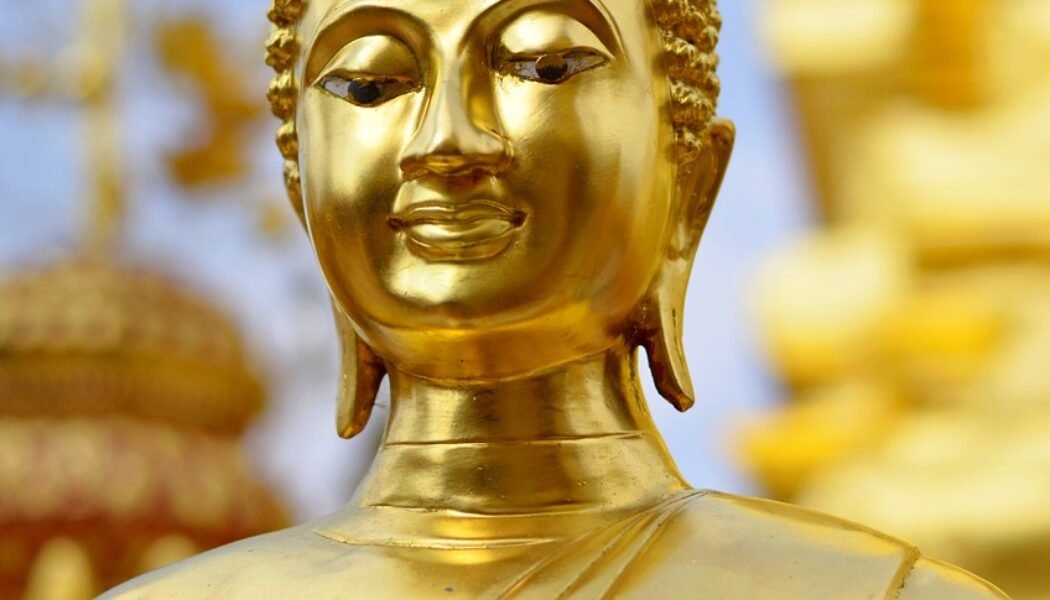Walking into a restaurant in Knoxville, Tennessee, I was immediately greeted by the serene gaze of a golden Buddha statue. Its gemstone eyes sparkled as I passed, and though the scents of Thai curries filled the air, I found myself lingering on those eyes, their glint suggesting more than just a decorative presence.
Sacred objects are everywhere—gracing museum galleries, adorning homes, or even standing in yards. Some shine with bejeweled splendor, while others carry the patina of generations of devotion. Often, it feels as if these sacred images are looking back at us.
The ways in which sacred objects convey divine presence in many Asian cultures offer a fascinating glimpse into how the material world intersects with the spiritual. My research focuses on this intersection, exploring how sacred images express divine power and how these objects are thought to come alive through ritual practices. These insights reveal the active roles such objects play in the lives of believers, urging us to think beyond the confines of religious contexts and reflect on the ways images shape our everyday world.
Sacred Visual Culture: Seeing and Being Seen
In Hindu practice, one of the central rituals is darśan—the act of seeing and being seen by the divine. In her landmark study of Indian visual culture, scholar Diana Eck describes darśan as “to stand in the presence of the deity and to behold the image with one’s own eyes, to see and be seen by the deity.” This interaction imbues the image with a sense of living presence, a connection between worshipper and divine.
In Theravada Buddhist rituals across Southeast Asia, sacred images undergo ceremonies to recharge their spiritual power. In northern Thailand, for example, monastics and laypeople gather for all-night chanting sessions, reciting Buddhist sutras while holding cords attached to a Buddha statue. As scholar Donald Swearer notes, this ritual forms an intricate web of connection between the statue and the community, reanimating the image so it can once again interact with believers.
Japanese Buddhist statues often contain relics—bones of saints, fragments of monastic robes, or silk replicas of organs. Art historian James Dobbins explains that these statues undergo rituals meant to transform their wooden bodies into living entities, capable of seeing, hearing, and responding to the needs of the faithful.
In these traditions, inanimate objects are thought to become sacred, living beings. Through ritual, they are transformed into active participants in the spiritual lives of worshippers, able to perceive and respond in ways that go beyond the material world.
The ‘Eye-Opening’ Ritual: Enlivening the Divine
The most widespread ritual for bringing sacred images to life is the “eye-opening” ceremony, performed in various forms across Asia. In this ritual, monks or spiritual leaders paint the pupils of an image, symbolically opening its eyes to the world. In Sri Lanka, this rite is known as the netra-pinkama, which translates as the “meritorious action of the eyes.” Before consecration, the statue is treated as no more than the materials from which it is made. But as scholar Richard Gombrich has noted, the act of consecration transforms it into a living entity, infused with divine presence.
This process is not taken lightly. Ritual specialists must undergo purification, as any interference from malevolent forces could render the image ineffective or dangerous. During the final act of painting the eyes, the officiant avoids looking directly at the image, using a mirror to paint the pupils without making eye contact—a precaution against confronting the image’s newly awakened power too directly.
In Taiwan, a similar practice known as kaiguang, or “opening the radiance,” is performed on statues and paintings of Buddhist, Daoist, and local gods. After the ceremony, a piece of red paper is often wrapped around the statue’s eyes to ensure that the first thing the image sees is the face of the person who commissioned it. Such rituals reflect the profound belief in the power of sacred vision, a force that must be carefully managed.
Living Images: More Than Meets the Eye
Once an image’s eyes have been opened, it is treated as a living presence capable of powerful deeds. People make offerings of incense, take care to follow social etiquette, and behave in ways that reflect the belief that the statue is not merely symbolic but a living entity worthy of respect. The meticulous care given to these objects reveals that something far deeper is at play.
As Eck observes, the act of seeing and being seen is crucial to understanding the role of sacred images. When these images seem to look back at us, they remind us that we are not alone. In this exchange, they challenge the notion that the world exists solely for our observation, suggesting instead that other perspectives—whether divine or human—are just as powerful.
In many Asian cultures, sacred images are not simply inert objects of devotion. Through ritual, they become alive, engaging with worshippers in ways that transcend the material world. These practices remind us that images hold a special power—one that speaks not only to the spiritual but also to the deeper ways in which we relate to the world around us.
Source: The Conversation


